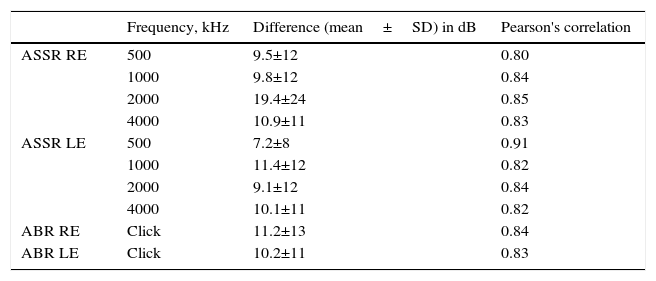Conventional audiometry is the gold standard for quantifying and describing hearing loss. Alternative methods become necessary to assess subjects who are too young to respond reliably. Auditory evoked potentials constitute the most widely used method for determining hearing thresholds objectively; however, this stimulus is not frequency specific. The advent of the auditory steady-state response (ASSR) leads to more specific threshold determination.
The current study describes and compares ASSR, auditory brainstem response (ABR) and conventional behavioural tone audiometry thresholds in a group of infants with various degrees of hearing loss.
MethodsA comparison was made between ASSR, ABR and behavioural hearing thresholds in 35 infants detected in the neonatal hearing screening programme.
ResultsMean difference scores (±SD) between ABR and high frequency ABR thresholds were 11.2dB (±13) and 10.2dB (±11). Pearson correlations between the ASSR and audiometry thresholds were 0.80 and 0.91 (500Hz); 0.84 and 0.82 (1000Hz); 0.85 and 0.84 (2000Hz); and 0.83 and 0.82 (4000Hz).
ConclusionThe ASSR technique is a valuable extension of the clinical test battery for hearing-impaired children.
La audiometría convencional es el patrón de referencia para cuantificar y describir una hipoacusia. Sin embargo, se precisan métodos alternativos para los pacientes muy jóvenes que no pueden responder con fiabilidad. Los potenciales evocados auditivos de tronco (PEATC) es el método más extendido para determinar de forma objetiva los umbrales auditivos, sin embargo, no informan específicamente en cada frecuencia. La llegada de los potenciales evocados de estado estable (PEAEE) permite conseguir una determinación más específica en frecuencias.
El presente trabajo describe y compara los umbrales obtenidos mediante PEATC, PEAEE y audiometría convencional en un grupo de niños que presentan varios grados de pérdida auditiva.
MétodosSe llevó a cabo una comparación entre los umbrales de PEATC, PEAEE y audiométricos obtenidos de 35 niños detectados en el programa de cribado auditivo neonatal.
ResultadosLa diferencia media (±DE) entre los umbrales de los PEATC y la banda de 4.000Hz de los PEAEE fueron 11,2 dB (±13) para el oído derecho y 10,2 dB (±11) para el izquierdo. Las correlaciones de Pearson entre los umbrales de los PEAEE y audiométricos fue 0,80 y 0,91 (500Hz); 0,84 y 0,82 (1.000Hz); 0,85 y 0,84 (2.000Hz); 0,83 y 0,82 (4.000Hz), respectivamente para oído derecho e izquierdo.
ConclusiónLa técnica de los PEAEE es una técnica a tener en cuenta para su inclusión en la batería de test que se emplea en el diagnóstico audiológico de los niños con hipoacusia.








